Cohen I.M., Kundu P.K. Fluid Mechanics
Подождите немного. Документ загружается.

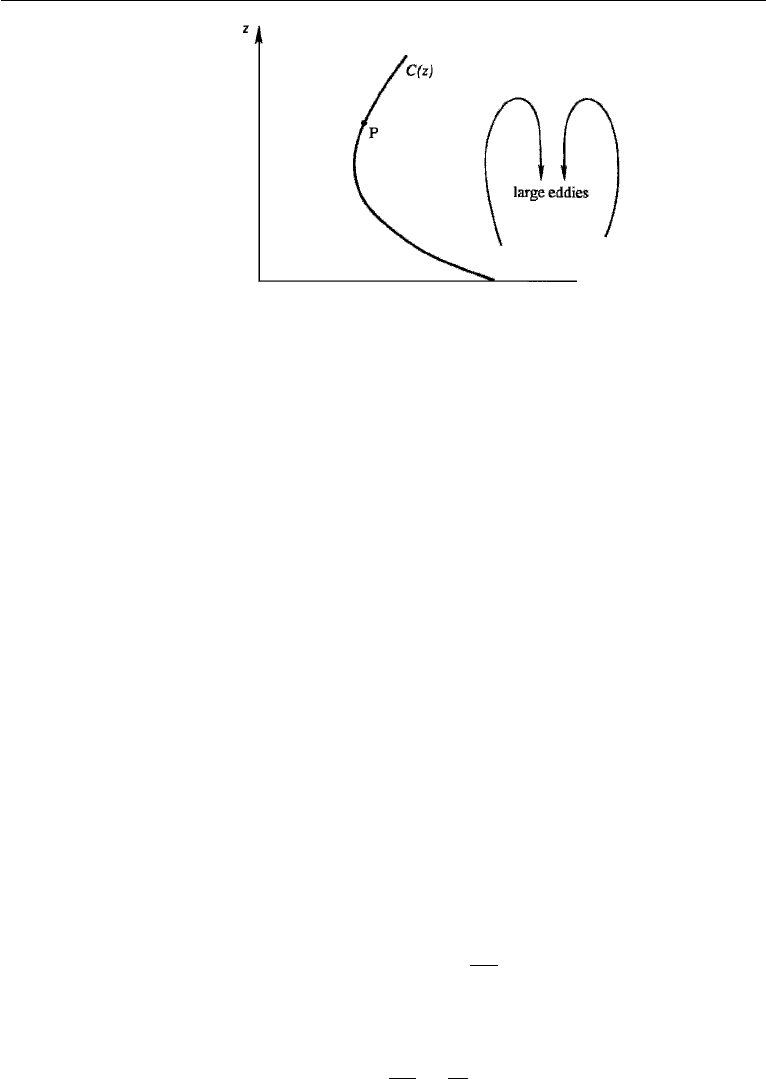
582 Turbulence
Figure 13.21 An illustration of breakdown of an eddy diffusivity type relation. The eddies are larger than
the scale of curvature of the concentration profile C(z) of carbon monoxide.
In cases where the concept of eddy viscosity may work, we may use the analogy
with equation (13.62), and write
ν
e
∼ u
l
m
, (13.65)
where u
is a typical scale of the fluctuating velocity, and l
m
is the mixing length,
defined as the cross-stream distance traveled by a fluid particle before it gives up its
momentum and loses identity. The concept of mixing length was first introduced by
Taylor (1915), but the approach was fully developed by Prandtl and his coworkers.
As with the eddy viscosity approach, little progress has been made by introducing the
mixing length, because u
and l
m
are just as unknown as ν
e
is. Experience shows that
in many situations u
is of the order of either the local mean speed U or the friction
velocity u
∗
. However, there does not seem to be a rational approach for relating l
m
to
the mean flow field.
Prandtl derived the logarithmic velocity distribution near a solid surface by using
the mixing length theory in the following manner. The scale of velocity fluctuations
in a wall-bounded flow can be taken as u
∼ u
∗
. Prandtl also argued that the mixing
length must be proportional to the distance y. Then equation (13.65) gives
ν
e
= ku
∗
y.
For points outside the viscous sublayer but still near the wall, the Reynolds stress can
be taken equal to the wall stress ρu
2
∗
. This gives
ρu
2
∗
= ρku
∗
y
dU
dy
,
which can be written as
dU
dy
=
u
∗
ky
. (13.66)

12. Eddy Viscosity and Mixing Length 583
This integrates to
U
u
∗
=
1
k
ln y + const.
In recent years the mixing length theory has fallen into disfavor, as it is incorrect
in principle (Tennekes and Lumley, 1972). It only works when there is a single length
scale and a single time scale; for example in the overlap layer in a wall-bounded
flow the only relevant length scale is y and the only time scale is y/u
∗
. However, its
validity is then solely a consequence of dimensional necessity and not of any other
fundamental physics. Indeed it was shown in the preceding section that the loga-
rithmic velocity distribution near a solid surface can be derived from dimensional
considerations alone. (Since u
∗
is the only characteristic velocity in the problem, the
local velocity gradient dU/dy can only be a function of u
∗
and y. This leads to equa-
tion (13.66) merely on dimensional grounds.) Prandtl’s derivation of the empirically
known logarithmic velocity distribution has only historical value.
However, the relationship (13.65) is useful for estimating the order of magnitude
of the eddy diffusivity in a turbulent flow, if we interpret the right-hand side as
simply the product of typical velocity and length scales of large eddies. Consider the
thermal convection between two horizontal plates in air. The walls are separated by
a distance L = 3 m, and the lower layer is warmer by T = 1
◦
C. The equation of
motion (13.33) for the fluctuating field gives the vertical acceleration as
Dw
Dt
∼ gαT
∼
gT
T
, (13.67)
where we have used the fact that the temperature fluctuations are expected to be of
order T and that α = 1/T for a perfect gas. The time to rise through a height L is
t ∼ L/w, so that equation (13.67) gives a characteristic velocity fluctuation of
w ∼
gLT /T ≈
√
0.1m/s ≈ 0.316 m/s.
It is fair to assume that the largest eddies are as large as the separation between the
plates. The eddy diffusivity is therefore
κ
e
∼ wL ∼ 0.95 m
2
/s,
which is much larger than the molecular value of 2 × 10
−5
m
2
/s.
As noted in the preceding, the Reynolds averaged Navier–Stokes equations do
not form a closed system. In order for them to be predictive and useful in solving
problems of scientific and engineering interest, closures must be developed. Reynolds
stresses or higher correlations must be expressed in terms of themselves or lower cor-
relations with empirically determined constants. An excellent review of an important
class of closures is provided by Speziale (1991). Critical discussions of various clo-
sures together with comparisons with each other, with experiments, or with numerical
simulations are given for several idealized problems. Very tragically, Charles Speziale
died while at the peak of his intellectual productivity. He contributed numerous papers

584 Turbulence
on turbulence modeling and other subjects on the foundations of fluid mechanics. A
memorial tribute and a number of papers on turbulence in his honor by some of the
prominent authorities may be found in the May 2006 issue of Journal of Applied
Mechanics (v. 73, no. 3).
A different approach to turbulence modeling is represented by renormalization
group (RNG) theories. Rather than use the Reynolds averaged equations, turbulence
is simulated by a solenoidal isotropic random (body) force field f (force/mass). Here
f is chosen to generate the velocity field described by the Kolmogorov spectrum in
the limit of large wavenumber K. For very small eddies (larger wavenumbers beyond
the inertial subrange), the energy decays exponentially by viscous dissipation. The
spectrum in Fourier space (K) is truncated at a cutoff wavenumber and the effect
of these very small scales is represented by a modified viscosity. Then an iteration
is performed successively moving back the cutoff into the inertial range. Smith and
Reynolds (1992) provide a tutorial on the RNG method developed several years
earlier by Yakhot and Orszag. Lam (1992) develops results in a different way and
offers insights and plausible explanations for the various artifices in the theory.
13. Coherent Structures in a Wall Layer
The large-scale identifiable structures of turbulent events, called coherent structures,
depend on the type of flow. A possible structure of large eddies found in the outer parts
of a boundary layer, and in a wall-free shear flow, was illustrated in Figure 13.10. In
this section we shall discuss the coherent structures observed within the inner layer
of a wall-bounded shear flow. This is one of the most active areas of current turbulent
research, and reviews of the subject can be found in Cantwell (1981) and Landahl
and Mollo-Christensen (1986).
These structures are deduced from spatial correlation measurements, a certain
amount of imagination, and plenty of flow visualization. The flow visualization
involves the introduction of a marker, one example of which is dye. Another involves
the “hydrogen bubble technique,” in which the marker is generated electrically. A thin
wire is stretched across the flow, and a voltage is applied across it, generating a line
of hydrogen bubbles that travel with the flow. The bubbles produce white spots in the
photographs, and the shapes of the white regions indicate where the fluid is traveling
faster or slower than the average.
Flow visualization experiments by Kline et al. (1967) led to one of the most
important advances in turbulence research. They showed that the inner part of the
wall layer in the range 5 <y
+
< 70 is not at all passive, as one might think. In fact,
it is perhaps dynamically the most active, in spite of the fact that it occupies only
about 1% of the total thickness of the boundary layer. Figure 13.22 is a photograph
from Kline et al. (1967), showing the top view of the flow within the viscous sublayer
at a distance y
+
= 2.7 from the wall. (Here x is the direction of flow, and z is the
“spanwise” direction.) The wire producing the hydrogen bubbles in the figure was
parallel to the z-axis. The streaky structures seen in the figure are generated by regions
of fluid moving downstream faster or slower than the average. The figure reveals that
the streaks of low-speed fluid are quasi-periodic in the spanwise direction. From
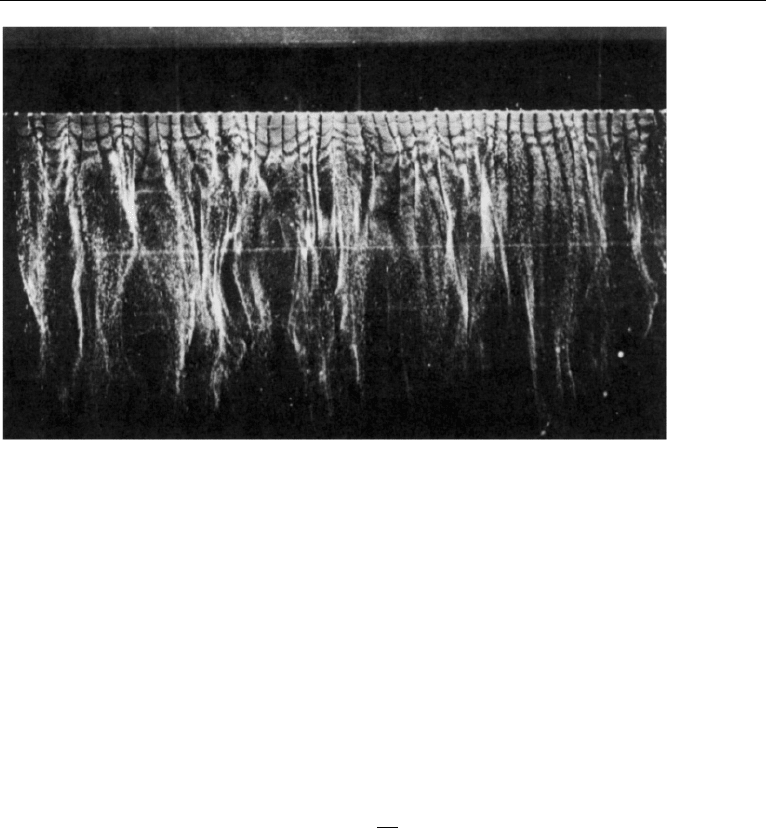
13. Coherent Structures in a Wall Layer 585
Figure 13.22 Top view of near-wall structure (at y
+
= 2.7) in a turbulent boundary layer on a horizontal
flat plate. The flow is visualized by hydrogen bubbles. S. J. Kline et al., Journal of Fluid Mechanics 30:
741–773, 1967 and reprinted with the permission of Cambridge University Press.
time to time these slowly moving streaks lift up into the buffer region, where they
undergo a characteristic oscillation. The oscillations end violently and abruptly as
the lifted fluid breaks up into small-scale eddies. The whole cycle is called bursting,
or eruption, and is essentially an ejection of slower fluid into the flow above. The
flow into which the ejection occurs decelerates, causing a point of inflection in the
profile u(y) (Figure 13.23). The secondary flow associated with the eruption motion
causes a stretching of the spanwise vortex lines, as sketched in the figure. These vortex
lines amplify due to the inherent instability of an inflectional profile, and readily break
up, producing a source of small-scale turbulence. The strengths of the eruptions vary,
and the stronger ones can go right through to the edge of the boundary layer.
It is clear that the bursting of the slow fluid associates a positive v with a nega-
tive u, generating a positive Reynolds stress −
uv. In fact, measurements show that
most of the Reynolds stress is generated by either the bursting or its counterpart,
called the sweep (or inrush) during which high-speed fluid moves toward the wall.
The Reynolds stress generation is therefore an intermittent process, occurring perhaps
25% of the time.
Largely due to numerical simulations of turbulent flows, it is now understood
that the very large turbulent wall shear stress (as compared with that in laminar
flow) is due to streamwise vorticity in the buffer or inner wall layer (y
+
= 10–50).
Kim (2003) reports on the history of discovery by computation and experimental
verification of insight into the details of turbulent flows. This insight led to strate-
gies to reduce the wall shear stress by active or passive controls. The availability
of microsensors and MEMS actuators creates the possibility of actively modifying
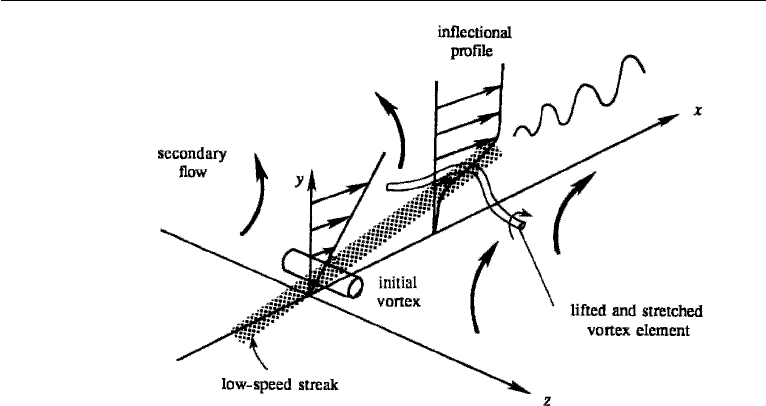
586 Turbulence
Figure 13.23 Mechanics of streak break up. S. J. Kline et al., Journal of Fluid Mechanics 30: 741–773,
1967 and reprinted with the permission of Cambridge University Press.
the flow near the wall to significantly reduce the shear stress. Passive modification
is exemplified by adding riblets to the surface. These are fine streamwise corruga-
tions that interfere with the interaction between the streamwise vortices and the wall.
Much smaller drag reduction is achieved this way. An example of active modification
of the near-wall flow is blowing and suctioning alternately on the surface to counter
the streamwise vorticity. A surprising result of these studies is that linear control
theory (for the Navier–Stokes equation linearized about a mean flow) provides excel-
lent results for a strategy for reducing wall shear stress, provided that function to be
extremized (which cannot be drag) is carefully chosen. All of these results apply only
for small turbulence Reynolds number (Re
∗
= u
∗
δ/ν). However, there has been a
history of success in applying insights gained for small Re
∗
to larger, more realistic
values.
14. Turbulence in a Stratified Medium
Effects of stratification become important in such laboratory flows as heat transfer
from a heated plate and in geophysical flows such as those in the atmosphere and in
the ocean. Some effects of stratification on turbulent flows will be considered in this
section. Further discussion can be found in Tennekes and Lumley (1972), Phillips
(1977), and Panofsky and Dutton (1984).
As is customary in geophysical literature, we shall take the z-direction as upward,
and the shear flow will be denoted by U(z). For simplicity the flow will be assumed
homogeneous in the horizontal plane, that is independent of x and y. The turbulence
in a stratified medium depends critically on the static stability. In the neutrally stable
state of a compressible environment the density decreases upward, because of the
decrease of pressure, at a rate dρ
a
/dz called the adiabatic density gradient. This

14. Turbulence in a Stratified Medium 587
is discussed further in Chapter 1, Section 10. A medium is statically stable if the
density decreases faster than the adiabatic decrease. The effective density gradient
that determines the stability of the environment is then determined by the sign of
d(ρ−ρ
a
)/dz, where ρ −ρ
a
is called the potential density. In the following discussion,
we shall assume that the adiabatic variations of density have been subtracted out, so
that when we talk about density or temperature, we shall really mean potential density
or potential temperature.
The Richardson Numbers
Let us first examine the equation for turbulent kinetic energy (13.34). Omitting the
viscous transport and assuming that the flow is independent of x and y, it reduces to
D
Dt
(q
2
) =−
∂
∂z
1
ρ
0
pw + q
2
w
−
uw
dU
dz
+ gα
wT
− ε,
where q
2
= (u
2
+ v
2
+ w
2
)/2. The first term on the right-hand side is the transport
of turbulent kinetic energy by fluctuating w. The second term −
uw(dU/dz) is the
production of turbulent energy by the interaction of Reynolds stress and the mean
shear; this term is almost always positive. The third term gα
wT
is the production of
turbulent kinetic energy by the vertical heat flux; it is called the buoyant production,
and was discussed in more detail in Section 7. In an unstable environment, in which
the mean temperature
¯
T decreases upward, the heat flux
wT
is positive (upward),
signifying that the turbulence is generated convectively by upward heat fluxes. In the
opposite case of a stable environment, the turbulence is suppressed by stratification.
The ratio of the buoyant destruction of turbulent kinetic energy to the shear production
is called the flux Richardson number:
Rf =
−gα
wT
−uw(dU/dz)
=
buoyant destruction
shear production
, (13.68)
where we have oriented the x-axis in the direction of flow. As the shear production
is positive, the sign of Rf depends on the sign of
wT
. For an unstable environment
in which the heat flux is upward Rf is negative and for a stable environment it is
positive. For Rf > 1, the buoyant destruction removes turbulence at a rate larger than
the rate at which it is produced by shear production. However, the critical value of Rf
at which the turbulence ceases to be self-supporting is less than unity, as dissipation
is necessarily a large fraction of the shear production. Observations indicate that the
critical value is Rf
cr
0.25 (Panofsky and Dutton, 1984, p. 94). If measurements
indicate the presence of turbulent fluctuations, but at the same time a value of Rf
much larger than 0.25, then a fair conclusion is that the turbulence is decaying.
When Rf is negative, a large −Rf means strong convection and weak mechanical
turbulence.
Instead of Rf, it is easier to measure the gradient Richardson number, defined as
Ri ≡
N
2
(dU/dz)
2
=
αg(d
¯
T/dz)
(dU/dz)
2
, (13.69)

588 Turbulence
where N is the buoyancy frequency. If we make the eddy coefficient assumptions
−
wT
= κ
e
d
¯
T
dz
,
−
uw = ν
e
dU
dz
,
then the two Richardson numbers are related by
Ri =
ν
e
κ
e
Rf. (13.70)
The ratio ν
e
/κ
e
is the turbulent Prandtl number, which determines the relative effi-
ciency of the vertical turbulent exchanges of momentum and heat. The presence
of a stable stratification damps the vertical transports of both heat and momentum;
however, the momentum flux is reduced less because the internal waves in a sta-
ble environment can transfer momentum (by moving vertically from one region to
another) but not heat. Therefore, ν
e
/κ
e
> 1 for a stable environment. Equation (13.70)
then shows that turbulence can persist even when Ri > 1, if the critical value of 0.25
applies on the flux Richardson number (Turner, 1981; Bradshaw and Woods, 1978).
In an unstable environment, on the other hand, ν
e
/κ
e
becomes small. In a neutral envi-
ronment it is usually found that ν
e
κ
e
; the idea of equating the eddy coefficients of
heat and momentum is called the Reynolds analogy.
Monin–Obukhov Length
The Richardson numbers are ratios that compare the relative importance of mechanical
and convective turbulence. Another parameter used for the same purpose is not a ratio,
but has the unit of length. It is the Monin–Obukhov length, defined as
L
M
≡−
u
3
∗
kαgwT
, (13.71)
where u
∗
is the friction velocity, wT
is the heat flux, α is the coefficient of thermal
expansion, and k is the von Karman constant introduced for convenience. Although
wT
is a function of z, the parameter L
M
is effectively a constant for the flow, as
it is used only in the logarithmic surface layer in which both the stress and the
heat flux
wT
are nearly constant. The Monin–Obukhov length then becomes a
parameter determined from the boundary conditions of drag and the heat flux at
the surface. Like Rf, it is positive for stable conditions and negative for unstable
conditions.
The significance of L
M
within the surface layer becomes clearer if we write
Rf in terms of L
M
, using the logarithmic velocity distribution (13.60), from which
dU/dz = u
∗
/kz. (Note that we are now using z for distances perpendicular to the
surface.) Using
uw = u
2
∗
because of the near uniformity of stress in the logarithmic
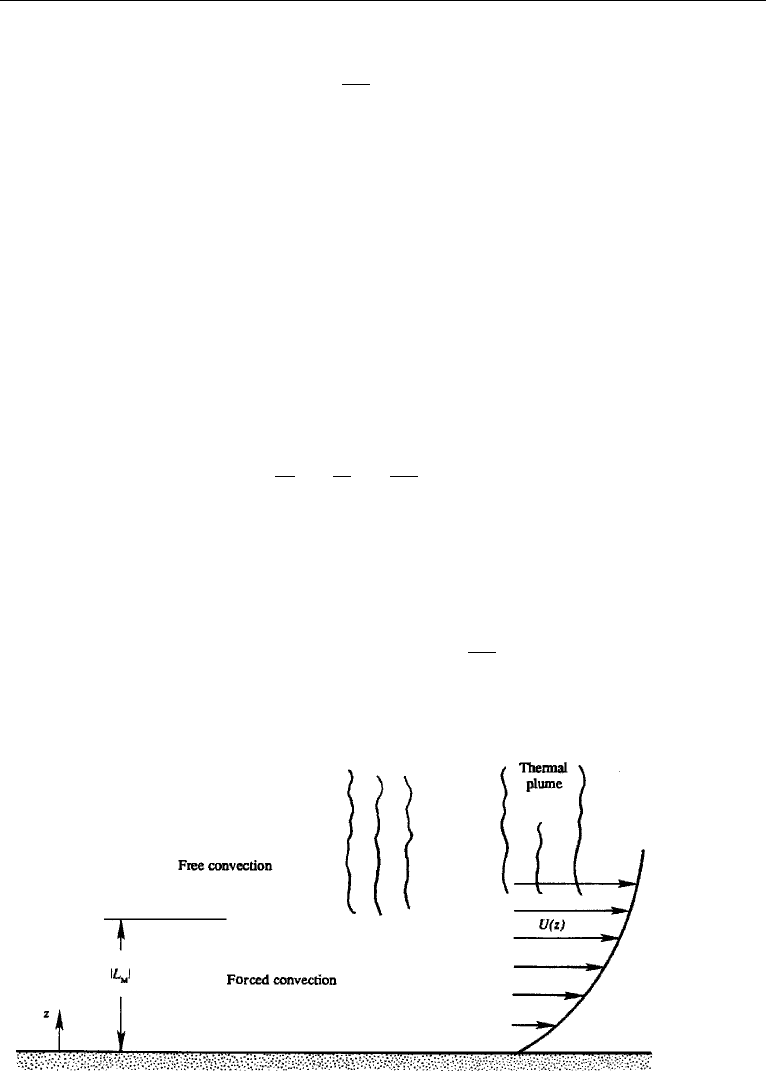
14. Turbulence in a Stratified Medium 589
layer, equation (13.68) becomes
Rf =
z
L
M
. (13.72)
As Rf is the ratio of buoyant destruction to shear production of turbulence, (13.72)
shows that L
M
is the height at which these two effects are of the same order.
For both stable and unstable conditions, the effects of stratification are slight if
z |L
M
|. At these small heights, then, the velocity profile is logarithmic, as in a
neutral environment. This is called a forced convection region, because the turbu-
lence is mechanically forced. For z |L
M
|, the effects of stratification dominate.
In an unstable environment, it follows that the turbulence is generated mainly by
buoyancy at heights z −L
M
, and the shear production is negligible. The region
beyond the forced convecting layer is therefore called a zone of free convection
(Figure 13.24), containing thermal plumes (columns of hot rising gases) characteristic
of free convection from heated plates in the absence of shear flow.
Observations as well as analysis show that the effect of stratification on the veloc-
ity distribution in the surface layer is given by the log-linear profile (Turner, 1973)
U =
u
∗
k
ln
z
z
0
+ 5
z
L
M
.
The form of this profile is sketched in Figure 13.25 for stable and unstable conditions.
It shows that the velocity is more uniform than ln z in the unstable case because of
the enhanced vertical mixing due to buoyant convection.
Spectrum of Temperature Fluctuations
An equation for the intensity of temperature fluctuations
T
2
can be obtained in a
manner identical to that used for obtaining the turbulent kinetic energy. The procedure
is therefore to obtain an equation for DT
/Dt by subtracting those for D
˜
T/Dt and
Figure 13.24 Forced and free convection zones in an unstable atmosphere.
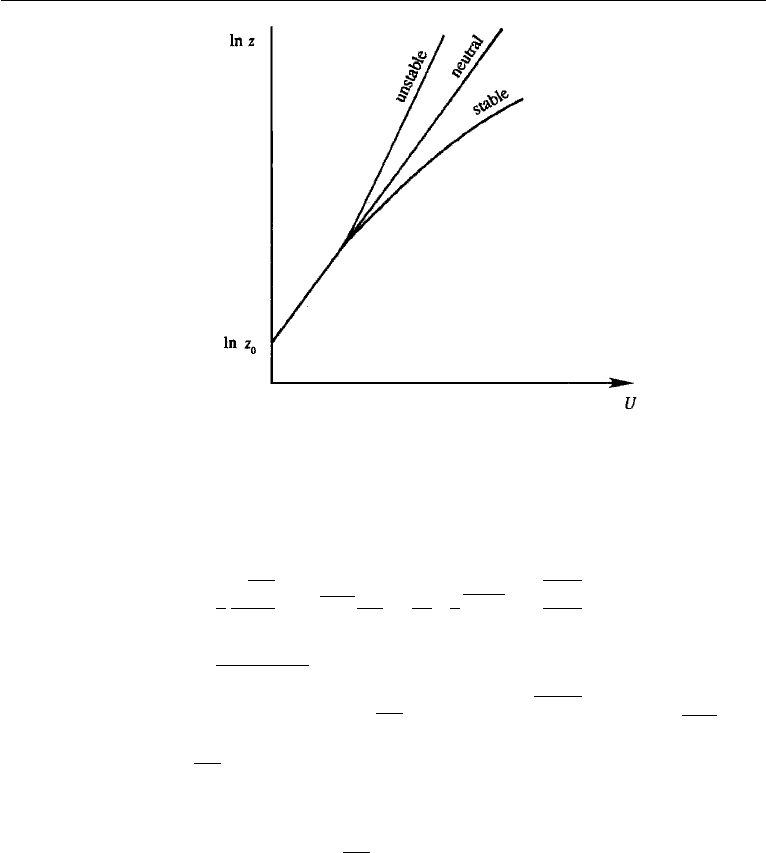
590 Turbulence
Figure 13.25 Effect of stability on velocity profiles in the surface layer.
D
¯
T/Dt, and then to multiply the resulting equation for DT
/Dt by T
and take the
average. The result is
1
2
D
T
2
Dt
=−
wT
d
¯
T
dz
−
∂
∂z
1
2
T
2
w − κ
dT
2
dz
− ε
T
,
where ε
T
≡ κ(∂T
/∂x
j
)
2
is the dissipation of temperature fluctuation, analogous
to the dissipation of turbulent kinetic energy ε = 2ν
e
ij
e
ij
. The first term on the
right-hand side is the generation of
T
2
by the mean temperature gradient, wT
being
positive if d
¯
T/dzis negative. The second term on the right-hand side is the turbulent
transport of
T
2
.
A wavenumber spectrum of temperature fluctuations can be defined such that
T
2
≡
∞
0
(K) dK.
As in the case of the kinetic energy spectrum, an inertial range of wavenumbers
exists in which neither the production by large-scale eddies nor the dissipation by
conductive and viscous effects are important. As the temperature fluctuations are
intimately associated with velocity fluctuations, (K) in this range must depend not
only on ε
T
but also on the variables that determine the velocity spectrum, namely ε
and K. Therefore
(K) = (ε
T
,ε,K) l
−1
K η
−1
.

15. Taylor’s Theory of Turbulent Dispersion 591
The unit of is
◦
C
2
m, and the unit of ε
T
is
◦
C
2
/s. A dimensional analysis gives
(K) ∝ ε
T
ε
−1/3
K
−5/3
l
−1
K η
−1
, (13.73)
which was first derived by Obukhov in 1949. Comparing with equation (13.40), it is
apparent that the spectra of both velocity and temperature fluctuations in the inertial
subrange have the same K
−5/3
form.
The spectrum beyond the inertial subrange depends on whether the Prandtl num-
ber ν/κ of the fluid is smaller or larger than one. We shall only consider the case of
ν/κ 1, which applies to water for which the Prandtl number is 7.1. Let η
T
be the
scale responsible for smearing out the temperature gradients and η be the Kolmogorov
microscale at which the velocity gradients are smeared out. For ν/κ 1 we expect
that η
T
η, because then the conductive effects are important at scales smaller than
the viscous scales. In fact, Batchelor (1959) showed that η
T
η(κ/ν)
1/2
η.In
such a case there exists a range of wavenumbers η
−1
K η
−1
T
, in which the
scales are not small enough for the thermal diffusivity to smear out the temperature
fluctuation. Therefore, (K) continues farther up to η
−1
T
, although S(K) drops off
sharply. This is called the viscous convective subrange, because the spectrum is dom-
inated by viscosity but is still actively convective. Batchelor (1959) showed that the
spectrum in the viscous convective subrange is
(K) ∝ K
−1
η
−1
K η
−1
T
. (13.74)
Figure 13.26 shows a comparison of velocity and temperature spectra, observed in a
tidal flow through a narrow channel. The temperature spectrum shows that the spectral
slope increases from −
5
3
in the inertial subrange to −1 in the viscous convective
subrange.
15. Taylor’s Theory of Turbulent Dispersion
The large mixing rate in a turbulent flow is due to the fact that the fluid particles
gradually wander away from their initial location. Taylor (1921) studied this problem
and calculated the rate at which a particle disperses (i.e., moves away) from its initial
location. The presentation here is directly adapted from his classic paper. He consid-
ered a point source emitting particles, say a chimney emitting smoke. The particles
are emitted into a stationary and homogeneous turbulent medium in which the mean
velocity is zero. Taylor used Lagrangian coordinates X(a,t), which is the present
location at time t of a particle that was at location a at time t = 0. We shall take the
point source to be the origin of coordinates and consider an ensemble of experiments
in which we measure the location X(0,t) at time t of all the particles that started
from the origin (Figure 13.27). For simplicity we shall suppress the first argument in
X(0,t)and write X(t) to mean the same thing.
Rate of Dispersion of a Single Particle
Consider the behavior of a single component of X, say X
α
(α = 1, 2, or 3). (We are
using a Greek subscript α because we shall not imply the summation convention.)
